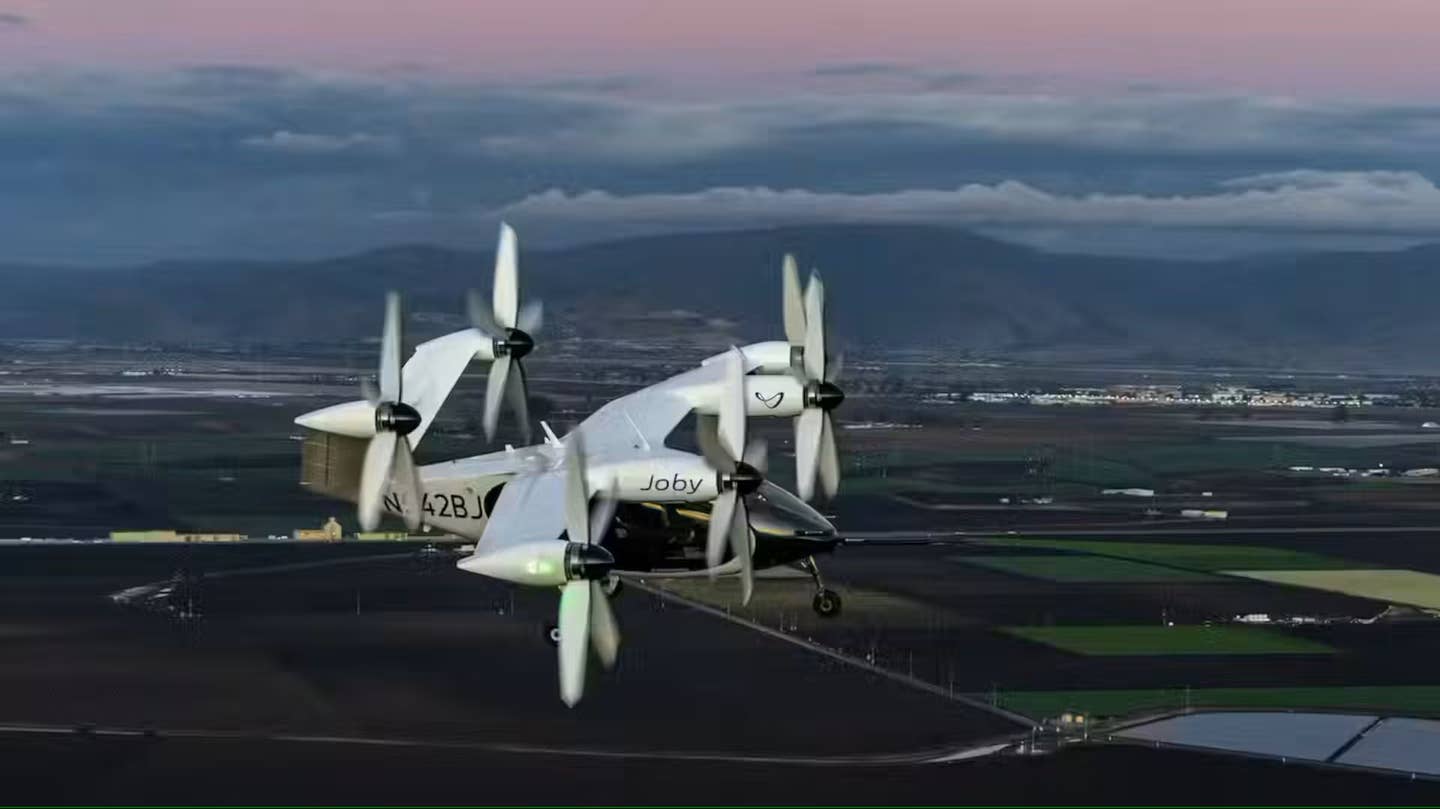FAA Approves Joby’s Electric Air Taxi Propulsion Certification Plan
The approval defines how Joby will demonstrate its electric propulsion system complies with FAA regulations.

Joby’s electric air taxi takes flight above Marina, California, the site of the company’s pilot production facility. [Courtesy: Joby Aviation]
Joby Aviation says it has achieved another “critical step” toward type certification of its electric vertical takeoff and landing (eVTOL) air taxi.
The manufacturer on Friday revealed that the FAA accepted its propulsion system certification plan, one of several documents that tells the regulator how the company will demonstrate compliance with aviation regulations. According to Joby, all structural, mechanical, and electrical system certification plans for its five-seat air taxi have now been approved.
Didier Papadopoulos, president of aircraft OEM at Joby, said the certification helps “sets the stage” for the firm to successfully complete for-credit FAA flight evaluations, which it expects to conduct later this year.
“I’m grateful to the incredible Joby team as well as the dedicated personnel at the FAA who continue to work hard to bring safety and innovation together, keeping the United States at the forefront of new aviation technology and capabilities,” said Papadopoulos.
FAA type certification reviews the design, manufacturing, and performance of new aircraft models presented for operation in the U.S., including their propulsion systems. Joby is in the third of five stages in that rigorous process.
The manufacturer designed its own propulsion system, which includes six dual-wound electric motors powered by isolated battery packs. This provides redundancy and eliminates single points of failure. The distributed electric propulsion configuration also reduces emissions and noise—Joby claims the latter is “as quiet as a conversation” during flight. Company presentations indicate a noise level of 45 dBA.
The company said its production prototype aircraft, rolled off the production line in June, delivers “nearly twice the power of the Tesla Model S Plaid, despite being lighter.”
The FAA-accepted propulsion certification plan covers Joby’s electric propulsion unit, propeller system, variable pitch actuation, coolant pump, nacelles, and the associated electrical wiring. It lays out definitive criteria to certify those systems for commercial passenger operations.
According to the manufacturer, all but one of its certification plans have been accepted by the regulator, and the final document is under review. As it nears completion of the third stage of type certification, the company said it has now shifted focus to the fourth phase, which comprises testing and analysis of aircraft systems and components.
In 2023, Joby completed 30 for-credit tests with the FAA, evaluating aircraft components such as flight electronics and structural materials. October marked the beginning of crewed flight testing, a critical milestone in development. The challenge now will be putting everything together for the final FAA evaluations.
Joby this week also obtained FAA Part 145 Repair Station certification, which the company will use initially to perform select maintenance, repair, and overhaul (MRO) activities on traditional aircraft. The approval further clears the way for expanded MRO services following type certification of its air taxi. Competitor Archer Aviation announced on the same day it had received its Part 145 certificate, as well.
Joby’s zero-emission air taxi is designed for a pilot to fly as many as four passengers on 100 sm (87 nm) trips at cruise speeds as fast as 200 mph (174 knots), while producing a “fraction” of the noise emitted by helicopters. The company requires type certification before its intended commercial launch in 2025, in partnership with Delta Air Lines.
Unlike most of its competitors, Joby intends to operate its air taxis itself, initially in metro areas such as New York and Los Angeles. The manufacturer recently collaborated with NASA to simulate air taxi traffic around airports, evaluating the integration of operations alongside conventional aircraft. A group of active and retired air traffic controllers was recruited to assist with the simulations.
Like this story? We think you'll also like the Future of FLYING newsletter sent every Thursday afternoon. Sign up now.

Sign-up for newsletters & special offers!
Get the latest FLYING stories & special offers delivered directly to your inbox






